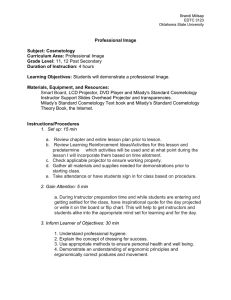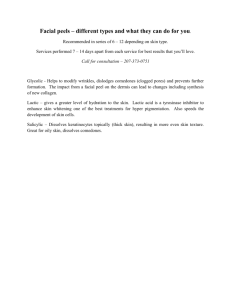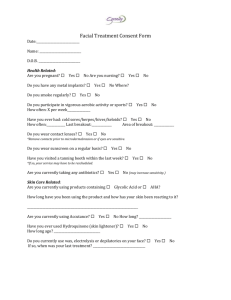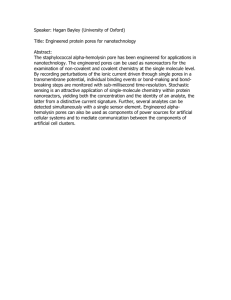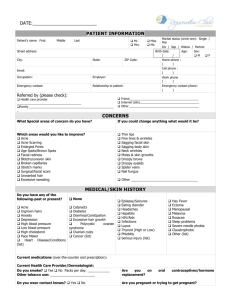Week 7 Lesson Plan 1
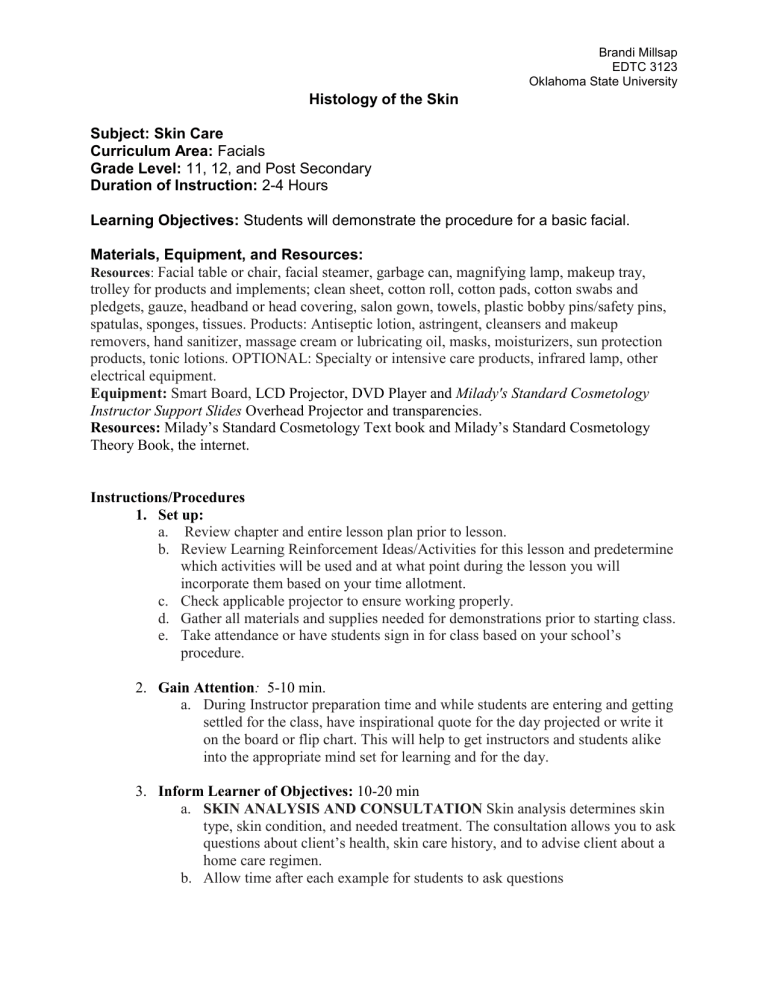
Brandi Millsap
EDTC 3123
Oklahoma State University
Histology of the Skin
Subject: Skin Care
Curriculum Area: Facials
Grade Level: 11, 12, and Post Secondary
Duration of Instruction: 2-4 Hours
Learning Objectives: Students will demonstrate the procedure for a basic facial.
Materials, Equipment, and Resources:
Resources : Facial table or chair, facial steamer, garbage can, magnifying lamp, makeup tray, trolley for products and implements; clean sheet, cotton roll, cotton pads, cotton swabs and pledgets, gauze, headband or head covering, salon gown, towels, plastic bobby pins/safety pins, spatulas, sponges, tissues. Products: Antiseptic lotion, astringent, cleansers and makeup removers, hand sanitizer, massage cream or lubricating oil, masks, moisturizers, sun protection products, tonic lotions. OPTIONAL: Specialty or intensive care products, infrared lamp, other electrical equipment.
Equipment: Smart Board, LCD Projector, DVD Player and Milady's Standard Cosmetology
Instructor Support Slides Overhead Projector and transparencies.
Resources: Milady’s Standard Cosmetology Text book and Milady’s Standard Cosmetology
Theory Book, the internet.
Instructions/Procedures
1.
Set up: a.
Review chapter and entire lesson plan prior to lesson. b.
Review Learning Reinforcement Ideas/Activities for this lesson and predetermine which activities will be used and at what point during the lesson you will incorporate them based on your time allotment. c.
Check applicable projector to ensure working properly. d.
Gather all materials and supplies needed for demonstrations prior to starting class. e.
Take attendance or have students sign in for class based on your school’s procedure.
2.
Gain Attention: 5-10 min.
a.
During Instructor preparation time and while students are entering and getting settled for the class, have inspirational quote for the day projected or write it on the board or flip chart. This will help to get instructors and students alike into the appropriate mind set for learning and for the day.
3.
Inform Learner of Objectives: 10-20 min a.
SKIN ANALYSIS AND CONSULTATION Skin analysis determines skin type, skin condition, and needed treatment. The consultation allows you to ask questions about client’s health, skin care history, and to advise client about a home care regimen. b.
Allow time after each example for students to ask questions
Brandi Millsap
EDTC 3123
Oklahoma State University
1.
2.
3.
Accutane: Or any other skin-thinning or exfoliating drug, including Retin-A,
Renoval, Tazorac, Differin, etc. If client is using one of these, avoid exfoliation, peeling, or stimulating treatments
Pregnancy: Use no electrical treatments or any other treatment without physician’s written permission. Pregnant women may develop sensitivities.
Metal bones or plates: If client has metal bones or plates, avoid all electrical
4.
5.
6.
treatment.
Pacemakers or heart irregularities: Avoid all electrical treatment.
Allergies: Avoid all products or substances to which the client is allergic.
Highly allergic clients should use fragrance-free products designed for sensitive skin.
Seizures or epilepsy: Avoid electrical and light treatments.
Oral steroids: Avoid stimulating or exfoliating treatment or waxing. 7.
8.
9.
Autoimmune diseases such as lupus: Avoid any harsh or stimulating treatments.
Diabetes: Diabetics heal slowly; get physician’s approval before treatment
10.
Blood thinners: Avoid extraction or waxing
11.
Obvious skin abnormalities: Open sores, fever blisters (herpes simplex)
12.
should be referred to a physician.
When in doubt . . .
Don’t!
4.
Present Stimulus Material: 5-7 min a.
HEALTH SCREENING: The form allows you to obtain additional important information from the client.
1. Client data: Name, address, and phone number.
2. Client’s occupation:
3. Medical conditions: That might affect treatment.
4. Medications: Any medications client is using including topical drugs for skin.
5. Home care regimen: What kind of products clients are using at home or prior treatments.
6. How client heard about you: This allows you to recognize a client who referred or how to focus your advertising. Figure 22–2 in text
5.
Provide Learner Guidance: 15-20 min a. Before Facial
1. Have client change into smock.
2.
Seat client in chair.
3. Drape client. Use hair cap, headband, or towels.
4. Have client remove jewelry.
5. Recline client in chair.
6. Warm cleansing milk and apply. Use an upward circular movement.
Brandi Millsap
EDTC 3123
Oklahoma State University
Cleanse eye area with eye makeup remover. Use damp facial sponges or cotton pads.
7. Apply cotton eye pads to client’s eyes. b. DETERMINE SKIN TYPE: Skin type is determined by how oily or dry the skin is. Skin type is hereditary and cannot be permanently changed with treatment. Skin conditions are characteristics of the skin associated with a particular skin type.
1. Alipidic Alipidic means lack of liquids. Alipidic skin becomes dehydrated (or dry) because it does not produce enough sebum to prevent the evaporation of cell moisture.
2. Oily Oily skin: produces too much sebum and will have large pores.
Skin will appear shiny or even greasy. Pores may be clogged from dead cells building up in hair follicles. Open comedones (blackheads) may be present. Open comedones are a mixture of solidified sebum and dead cell buildup stuck in the follicles. Closed comedones are small bumps just underneath the skin surface. The difference between closed and open comedones is the size of the follicle opening or ostium.
See Table 22–1.
For an example
3. Normal: Normal skin has even pore distribution. It is very soft with a smooth surface and lacks wrinkles. Normal skin is unusual.
4.
Combination dry In combination dry skin, the pores are obvious down the center of the face. The outer edges of the face have pores that are not visible or become smaller.
5.
Combination oily: In combination oily skin, there is a wider distribution of large pores down the center of the face. Those pores extend to the outer cheeks. Pores become smaller toward the edges of the face.
6.
Acne With acne: the pores are very large in all areas. Acne is considered a skin type because it is hereditary. There is a presence of numerous open and closed comedones, clogged pores, and red papules and pustules (pimples).
6.
Elicit Performance/Provide Feedback: 20-30 min a.
Show the Milady DVD of the previous steps:
This will include prepping for a client, health check, skin analysis, facial, and clean up. b.
Discuss the video and give examples of different scenarios c.
Have students prepare a power point containing at least 10 slides over one of the sub topics that we discussed in class. Assign one topic to each student, so all of the topics get covered. Students need to make sure that they include
Brandi Millsap
EDTC 3123
Oklahoma State University everything that we covered about that topic in class and also do some research. This will be used as a learning tool to prepare them for the State
Board of Cosmetology Exam.
7.
Assess Performance: 5-7 min
Power point will need to include:
Ten slides
At least 5 slides need to have pictures with animation
Creative
Do not read text off of slide show, word for word
8.
Enhance Retention and Transfer: 30-60 min
Allow students to discuss and ask questions during lesson.
After students give power point presentations let them discuss and ask classmates questions.
Have students practice all aspects of the facial on one another.
After they have completed all successfully, let them practice on clients.
Integration of Technology:
The technologies that were used in this lesson included a DVD player, DVD, Smart
Board, Overhead projector to show slides of different skin types. This lesson plan is better by incorporating the technologies, because this allows the students to see examples of what is being covered in the lesson. In the case of skin, a picture is worth a thousand words. The DVD provides a great example of exactly how the student needs to prep, complete, and clean up after performing a facial.
Standards:
Everything that is taught is Oklahoma State Board Requirements. Students take a practical
Exam and written test for State licensure. The Oklahoma Department of Career Tech also requires me to teach Board Approved curriculum.
OK PASS:
ISTE NETS*S:
ISTE NETS*T:
Evaluation/Assessment:
The students will be evaluated based on the Rubric Provided. Everything that is taught in the classroom will also be evaluated when the students take their State Board written and Practical
Exams.
Brandi Millsap
EDTC 3123
Oklahoma State University
Grading
Dimensions
Accuracy
Complete
Needs
Improvement
Did not cover topic provided
Did not include all required aspects.
Below
Average
Average
Some factual inaccuracies
Power Point correctly represents basic facts
Occasional omissions from slide show
Presentation complete
Above
Average
All items in
Power Point
Presentation with additional information
Power Point and presentation includes some information
Presentation Poor, difficult to read Power
Point
Student Example:
PowerPoint placed in drop box.
Somewhat difficult to
Power
Point, mostly correct
Acceptable presentation
Power Point
Power Point and spoken clear and correct with some extra information
Excellent
Basic and extended facts included with complete accuracy as to detail
Power Point and presentation exceeded information
Clear, correct
Power Point and
Presentation with extra elements
